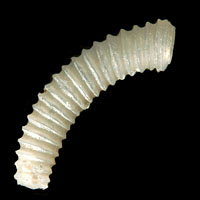|
< Previous family introduction |
|
|||||
 |
Family Caecidae Caecids
|
|||||
|
The Caecidae is a family of unusual shells that at first sight look as if they should be placed with the worm shells in Vermetidae, or even with the tusk shells in the class Scaphopoda. But structure of the animals show that they are most closely related to the Vitrinellide. There are two subfamilies. In the Caecinae the adult shells are simple curved tubes. The juvenile shells have a coiled protoconch and uncoiled teleoconch, but as soon as the shell has grown sufficiently to accommodate the animal the protoconch is lost and the open anterior end of the shell is plugged with a calcareous deposit. In the other subfamily, the Ctiloceratinae, the coiled protoconch remains attached to an uncoiled teleoconch, or the straight teleoconch reverts to coiled form. The family occurs in tropical and temperate seas throughout the world. They are found most commonly in shallow water, where they live on a variety of substrates including algae and seagrass, beneath rocks and rubble and in gravel. Bandel (1996) said they are abundant in shallow-water grass beds, and on open sand bottoms where they crawl around among algal thickets, feeding on detritus, minute algae and other organisms. Species of Caecinae are the most common, with the Ctiloceratinae being uncommon or rare. The Australian Caecidae have not been thoroughly documented, although the northern Australian forms of the subfamily Ctiloceratinae were described by Iredale & Laseron (1957). The family in Australia has 24 recognised species, of which three species are known in NSW. One of these, Caecum amputatum, is relatively common and has a southern Australian distribution, while the other two are very uncommon. All the species in NSW are known only from empty shells from beach washup and dredgings. Family References Bandel, K 1996. Phylogeny of the Caecidae (Caenogastropoda). Mitteilungen aus dem Geologisch-Paläontologischen Institut der Universität Hamburg 79: 53-115, pl. 1-13 Iredale, T. & Laseron, C.F. 1957. The systematic status of Ctiloceras and some comparative genera. Proceedings of the Royal Zoological Society of New South Wales 1955-56: 97-109 Coverage All the species known from NSW are detailed here. Identification Notes As mentioned above, the adult shells of the Caecinae are curved tubes from which the protoconch has been severed. The narrow end, from where the protoconch was removed, is closed by a calcareous plug; the wide end, which is the anterior end, is simple or slightly thickened. |